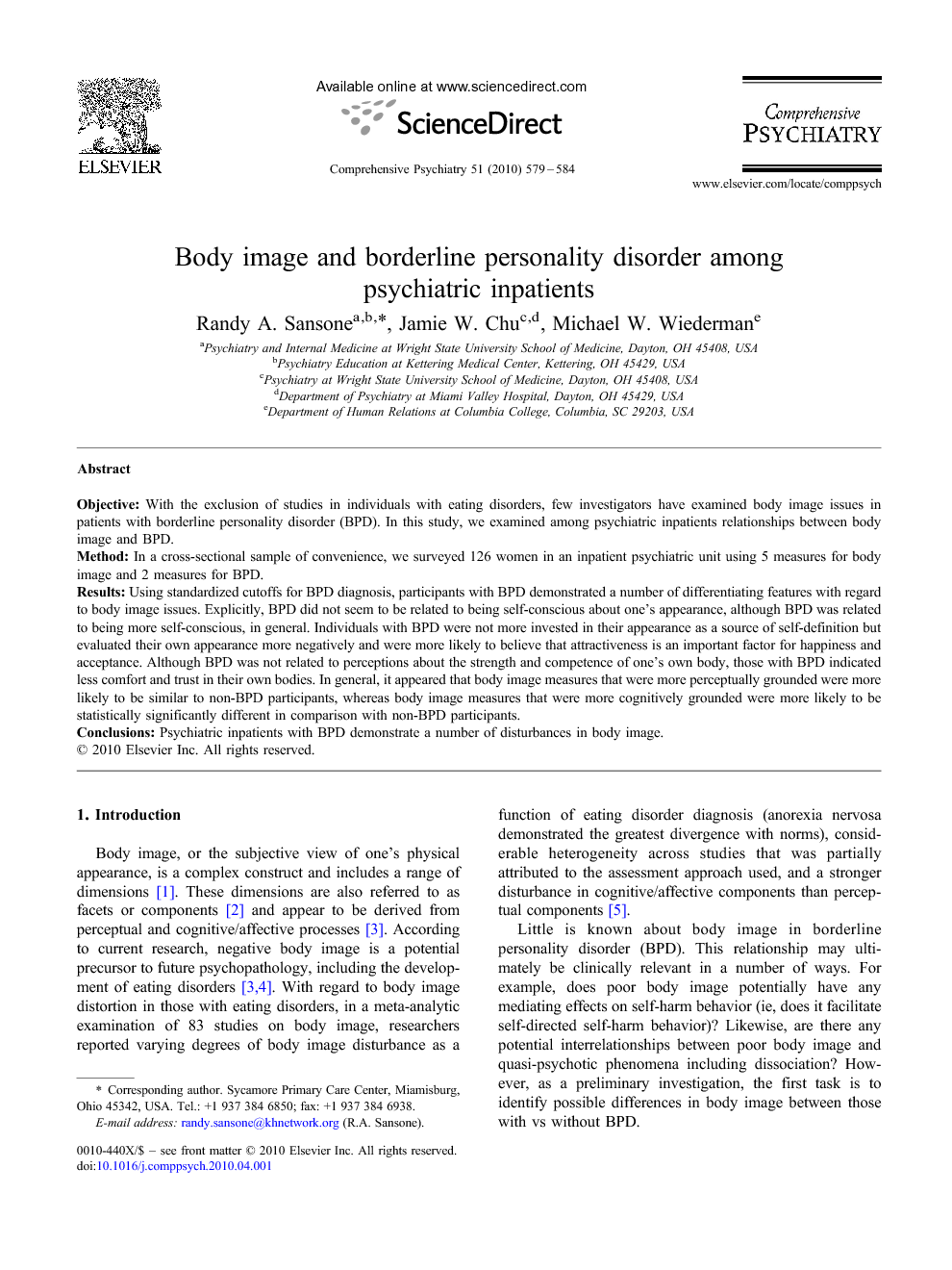With the exclusion of studies in individuals with eating disorders, few investigators have examined body image issues in patients with borderline personality disorder (BPD). In this study, we examined among psychiatric inpatients relationships between body image and BPD.
Body image, or the subjective view of one's physical appearance, is a complex construct and includes a range of dimensions [1]. These dimensions are also referred to as facets or components [2] and appear to be derived from perceptual and cognitive/affective processes [3]. According to current research, negative body image is a potential precursor to future psychopathology, including the development of eating disorders [3] and [4]. With regard to body image distortion in those with eating disorders, in a meta-analytic examination of 83 studies on body image, researchers reported varying degrees of body image disturbance as a function of eating disorder diagnosis (anorexia nervosa demonstrated the greatest divergence with norms), considerable heterogeneity across studies that was partially attributed to the assessment approach used, and a stronger disturbance in cognitive/affective components than perceptual components [5].
Little is known about body image in borderline personality disorder (BPD). This relationship may ultimately be clinically relevant in a number of ways. For example, does poor body image potentially have any mediating effects on self-harm behavior (ie, does it facilitate self-directed self-harm behavior)? Likewise, are there any potential interrelationships between poor body image and quasi-psychotic phenomena including dissociation? However, as a preliminary investigation, the first task is to identify possible differences in body image between those with vs without BPD.
Empirical studies on the relationship between body image and BPD are scant. Excluding studies of eating disorder samples, we were only able to locate 3 such studies. In the first study, Sansone et al [6] examined 48 women in an adult outpatient psychiatric clinic; after controlling for body mass index, investigators found relationships between self-rated bodily attractiveness (inverse relationship), facial attractiveness (inverse relationship), and social avoidance due to body image concerns, and scores on a self-report measure for BPD. In a German study, Haaf et al [7] examined 47 women with BPD, patients with bulimia nervosa, and healthy controls and found significant differences in body image scores among the 3 subsamples. However, the original report is in German, and the abstract did not indicate the body image factors that differentiated the BPD subsample from the other 2 subsamples. In a third study, Kazuko and Inoue [8] investigated 32 Japanese outpatients with BPD and compared them with other psychiatric outpatients and 216 college student controls. Distortion in body image was 1 of the 2 factors that most discriminated the BPD subsample from the other 2 subsamples, although the characterization of this feature was not available from the abstract (the original report is in Japanese). To summarize, little is actually known about the specific body image difficulties encountered in individuals with BPD, although such disturbances appear to vaguely characterize these patients.
In the following study, we examined several measures of body image in relationship to BPD among 126 female psychiatric inpatients. We hypothesized that those participants with BPD features would evidence higher disturbances on most of these measures compared with non-BPD participants.
Using standardized cutoffs for BPD diagnosis, participants with BPD demonstrated a number of differentiating features with regard to body image issues. Explicitly, BPD did not seem to be related to being self-conscious about one's appearance, although BPD was related to being more self-conscious, in general. Individuals with BPD were not more invested in their appearance as a source of self-definition but evaluated their own appearance more negatively and were more likely to believe that attractiveness is an important factor for happiness and acceptance. Although BPD was not related to perceptions about the strength and competence of one's own body, those with BPD indicated less comfort and trust in their own bodies. In general, it appeared that body image measures that were more perceptually grounded were more likely to be similar to non-BPD participants, whereas body image measures that were more cognitively grounded were more likely to be statistically significantly different in comparison with non-BPD participants.


